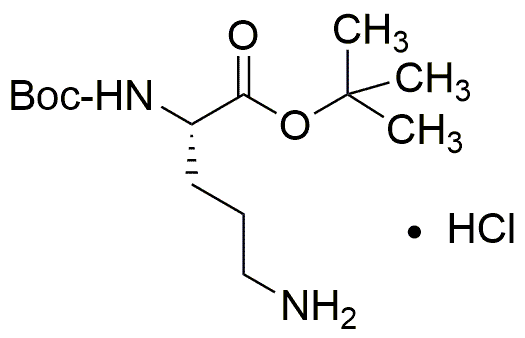Na-Boc-L-ornithine tert-butyl ester hydrochloride is widely utilized in research focused on:
- Peptide Synthesis: This compound serves as a key building block in the synthesis of peptides, particularly in the development of therapeutic agents and biologically active compounds.
- Drug Development: It plays a significant role in the pharmaceutical industry for creating prodrugs, enhancing the solubility and bioavailability of active pharmaceutical ingredients.
- Biotechnology: Used in the production of recombinant proteins, it helps in optimizing expression systems for better yields in biopharmaceutical manufacturing.
- Research in Neuroscience: This compound is utilized in studies related to neurotransmitter pathways, aiding in the understanding of neurological disorders and potential treatments.
- Cosmetic Formulations: Its properties make it valuable in the formulation of skin care products, where it can improve the stability and efficacy of active ingredients.
General Information
Properties
Safety and Regulations
Applications
Na-Boc-L-ornithine tert-butyl ester hydrochloride is widely utilized in research focused on:
- Peptide Synthesis: This compound serves as a key building block in the synthesis of peptides, particularly in the development of therapeutic agents and biologically active compounds.
- Drug Development: It plays a significant role in the pharmaceutical industry for creating prodrugs, enhancing the solubility and bioavailability of active pharmaceutical ingredients.
- Biotechnology: Used in the production of recombinant proteins, it helps in optimizing expression systems for better yields in biopharmaceutical manufacturing.
- Research in Neuroscience: This compound is utilized in studies related to neurotransmitter pathways, aiding in the understanding of neurological disorders and potential treatments.
- Cosmetic Formulations: Its properties make it valuable in the formulation of skin care products, where it can improve the stability and efficacy of active ingredients.
Documents
Safety Data Sheets (SDS)
The SDS provides comprehensive safety information on handling, storage, and disposal of the product.
Product Specification (PS)
The PS provides a comprehensive breakdown of the product’s properties, including chemical composition, physical state, purity, and storage requirements. It also details acceptable quality ranges and the product's intended applications.
Certificates of Analysis (COA)
Search for Certificates of Analysis (COA) by entering the products Lot Number. Lot and Batch Numbers can be found on a product’s label following the words ‘Lot’ or ‘Batch’.
Numéro de catalogue
Numéro de lot/série
Certificates Of Origin (COO)
This COO confirms the country where the product was manufactured, and also details the materials and components used in it and whether it is derived from natural, synthetic, or other specific sources. This certificate may be required for customs, trade, and regulatory compliance.
Numéro de catalogue
Numéro de lot/série
Safety Data Sheets (SDS)
The SDS provides comprehensive safety information on handling, storage, and disposal of the product.
DownloadProduct Specification (PS)
The PS provides a comprehensive breakdown of the product’s properties, including chemical composition, physical state, purity, and storage requirements. It also details acceptable quality ranges and the product's intended applications.
DownloadCertificates of Analysis (COA)
Search for Certificates of Analysis (COA) by entering the products Lot Number. Lot and Batch Numbers can be found on a product’s label following the words ‘Lot’ or ‘Batch’.
Numéro de catalogue
Numéro de lot/série
Certificates Of Origin (COO)
This COO confirms the country where the product was manufactured, and also details the materials and components used in it and whether it is derived from natural, synthetic, or other specific sources. This certificate may be required for customs, trade, and regulatory compliance.


